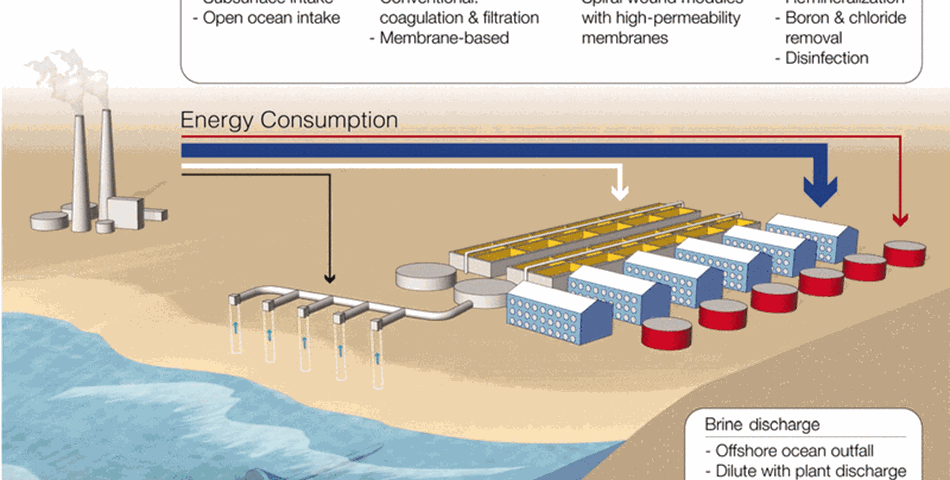The desalination of seawater to produce freshwater for human consumption can be achieved using either thermal processes, membrane processes, or a combination of both. Let’s start by briefly examining thermal technologies. In the late 19th century, a significant advancement in desalination technology occurred with the development of the multiple effect distillation (MED) process. In this process, preheated feed water flows over tubes in the first distillation “effect” or tank, where it is heated by prime steam, leading to the evaporation of a portion of the water content. This process of evaporation and condensation is repeated multiple times to produce the final product water, hence the term “multiple effect.” In the mid-1960s, multistage flash (MSF) distillation became popular, involving a flashing-cooling process repeated from one stage to the next to produce the desired product water.
Around the same time as MSF development, the first reverse osmosis (RO) membrane was developed. Reverse osmosis membranes work based on the principle of osmosis, a natural process involving the flow of water across a semi-permeable membrane barrier. Osmosis is selective, allowing water to pass through the membrane more rapidly than dissolved solids, leading to the separation of water and solids. The direction of water flow depends on its chemical potential, which is influenced by factors like pressure, temperature, and the concentration of dissolved solids.
When pure water is in contact with both sides of an ideal semi-permeable membrane at equal pressure and temperature, there is no net flow across the membrane because the chemical potential is equal on both sides. However, if a soluble salt is added to one side, the chemical potential of the salt solution is reduced, leading to osmotic flow from the pure water side across the membrane to the salt solution side. This continues until equilibrium is reached, where the hydrostatic pressure differential equals the osmotic pressure, a solution property independent of the membrane.
Applying external pressure to the salt solution side equal to the osmotic pressure causes equilibrium as well. Additional pressure above this equilibrium point increases the chemical potential of the water in the salt solution, causing solvent flow to the pure water side, a phenomenon known as reverse osmosis (RO). Applying RO to treat seawater is challenging because it requires high pressures, typically around 60-70 bar, to overcome osmotic pressure.
In the early days of RO desalination, positive displacement and centrifugal pumps supplied all the energy needed for a seawater RO (SWRO) plant. However, innovations in energy recovery have significantly improved energy efficiency over the last few decades. Today, waste energy from RO systems can be recovered from the concentrate flow, accounting for 25-30% of the energy required to overcome seawater’s osmotic pressure. This recovery is achieved using isobaric energy recovery devices (ERD).
In 2013, the desalination industry saw a significant increase in new capacity, with 6 million m³/d of new desalination plants becoming operational, compared to 4 million m³/d in 2012. While the 2013 growth rate was somewhat lower than in 2010, the demand for desalination continues to grow. During 2010-2013, industrial users, such as power stations and refineries, ordered 45% of new desalination plants, a notable increase from the previous four years when only 27% were ordered by industrial users.
Seawater desalination remains the most prominent application, representing 59% of global capacity, followed by brackish water applications at 22%, river water projects at 9%, wastewater recovery at 5%, and pure water systems at 5%. The Ras Al-Khair plant in Saudi Arabia, which combines membrane (RO) and thermal (MSF) technologies, is the world’s largest SWRO desalination plant, with a production capacity of 1,036,000 m³/d, providing drinking water and electricity to millions.
Improvements in isobaric ERDs and other desalination technologies are expected to continue, leading to increased energy efficiency, larger RO trains, and greater reliability in desalination plants, both thermal and RO-based. Pumps play a crucial role in these systems, and the focus is shifting toward more efficient and reliable pump designs that consider factors like cavitation, vibration, noise, and overall system performance. Ultimately, these advancements are likely to result in more cost-effective and sustainable desalination processes.
Dive deeper into the subject matter – click here to learn more!











